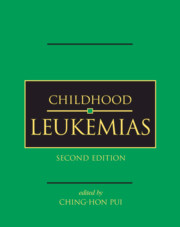Book contents
- Frontmatter
- Contents
- List of contributors
- Preface
- Part I History and general issues
- Part II Cell biology and pathobiology
- Part III Evaluation and treatment
- Part IV Complications and supportive care
- 29 Acute complications
- 30 Late complications after leukemia therapy
- 31 Therapy-related leukemias
- 32 Infectious disease complications in leukemia
- 33 Hematologic supportive care
- 34 Pain management
- 35 Psychosocial issues
- 36 Nursing care
- Index
- Plate Section between pages 400 and 401
- References
33 - Hematologic supportive care
from Part IV - Complications and supportive care
Published online by Cambridge University Press: 01 July 2010
- Frontmatter
- Contents
- List of contributors
- Preface
- Part I History and general issues
- Part II Cell biology and pathobiology
- Part III Evaluation and treatment
- Part IV Complications and supportive care
- 29 Acute complications
- 30 Late complications after leukemia therapy
- 31 Therapy-related leukemias
- 32 Infectious disease complications in leukemia
- 33 Hematologic supportive care
- 34 Pain management
- 35 Psychosocial issues
- 36 Nursing care
- Index
- Plate Section between pages 400 and 401
- References
Summary
Introduction
The great strides that have been made in curing children of acute leukemia can be attributed in part to improvements in supportive care during periods of morbidity due to therapeutic interventions. Such care is a major component of the total patient management strategy and includes nutritional support, prophylaxis against life-threatening infections, empiric use of antibiotics during periods of neutropenia, blood component support, adequate venous access, and, most recently, the use of hematopoietic growth factors to ameliorate hematologic complications. In this chapter, we review the current status of blood component support, intravenous catheter placement, and supportive therapy with granulocyte colony-stimulating factor and other cytokines. Although the focus is on experience with childhood leukemias, some examples are drawn from experience with solid tumor patients, particularly in situations where limited data are available from leukemia studies.
Blood component support
Since 1828, when Blundell initiated the use of blood transfusion to counteract postpartum hemorrhages, the demand for blood component products in the United States has increased exponentially. Each year, approximately 12 million units of blood are transfused in this country, with surgery, motor vehicle accidents, and complications of cancer accounting for the majority of this usage. Cancer patients receive blood component support because of deficient hemoglobin levels and platelet counts caused by the suppression of blood cell progenitors or by bone marrow aplasia due to tumor cell infiltration.
The use of red cell and plasma products has remained constant over the last decade, while platelet usage has steadily increased.
- Type
- Chapter
- Information
- Childhood Leukemias , pp. 829 - 849Publisher: Cambridge University PressPrint publication year: 2006
References
- 1
- Cited by



